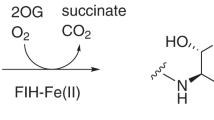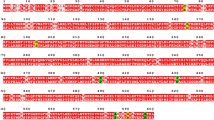Abstract
Crystal structures of human endothelial nitric oxide synthase (eNOS) and human inducible NOS (iNOS) catalytic domains were solved in complex with the arginine substrate and an inhibitor S-ethylisothiourea (SEITU), respectively. The small molecules bind in a narrow cleft within the larger active-site cavity containing heme and tetrahydrobiopterin. Both are hydrogen-bonded to a conserved glutamate (eNOS E361, iNOS E377). The active-site residues of iNOS and eNOS are nearly identical. Nevertheless, structural comparisons provide a basis for design of isozyme-selective inhibitors. The high-resolution, refined structures of eNOS (2.4 Å resolution) and iNOS (2.25 Å resolution) reveal an unexpected structural zinc situated at the intermolecular interface and coordinated by four cysteines, two from each monomer.
This is a preview of subscription content, access via your institution
Access options
Subscribe to this journal
Receive 12 print issues and online access
$189.00 per year
only $15.75 per issue
Buy this article
- Purchase on Springer Link
- Instant access to full article PDF
Prices may be subject to local taxes which are calculated during checkout






Similar content being viewed by others
References
Stuehr, D.J. Structure–function aspects in the nitric oxide synthases. Annu. Rev. Pharmacol. Toxicol. 37, 339– 59 (1997).
Nathan, C. Inducible nitric oxide synthase: what difference does it make? J. Clin. Invest. 100, 2417–2423 (1997).
Nakane, M. et al. Novel potent and selective inhibitors of inducible nitric oxide synthase. Mol. Pharmacol. 47, 831– 834 (1995).
Crane, B.R. et al. The structure of nitric oxide synthase oxygenase domain and inhibitor complexes. Science 278, 425– 431 (1997).
Crane, B.R. et al. Structure of nitric oxide synthase oxygenase dimer with pterin and substrate. Science 279, 2121– 2126 (1998).
Geller, D.A. et al. Molecular cloning and expression of inducible nitric oxide synthase from human hepatocytes. Proc. Natl. Acad. Sci. U.S.A. 90, 3491–3495 ( 1993).
Garvey, E.P. et al. Potent and selective inhibition of human nitric oxide synthases. Inhibition by non-amino acid isothioureas. J Biol. Chem. 269, 26669–26676 (1994).
Janssens, S.P., Simouchi, A., Quertermous, T., Bloch, D.B. & Bloch, K.D. Cloning and expression of a cDNA encoding human endothelium-derived relating factor/nitric oxide synthase. J. Biol. Chem. 267, 22694 ( 1992).
Deisenhofer, J. Crystallographic refinement and atomic models of a human Fc fragment and its complex with fragment B of protein A from Staphylococcus aureus at 2.9- and 2.8-A resolution. Biochemistry 20, 2361–2370 (1981).
Tzeng, E., Billiar, T.R., Robbins, P.D., Loftus, M. & Stuehr, D.J. Expression of human inducible nitric oxide synthase in a tetrahydrobiopterin (H4B)-deficient cell line: H4B promotes assembly of enzyme subunits into an active dimer. Proc. Natl. Acad. Sci. U.S.A. 92, 11771–11775 (1995).
Chen, P.F., Tsai, A.L. & Wu, K.K. Cysteine 99 of endothelial nitric oxide synthase (NOS-III) is critical for tetrahydrobiopterin-dependent NOS-III stability and activity. Biochem. Biophys. Res. Commun. 215, 1119 –1129 (1995).
Chen, P.F., Tsai, A.L. & Wu, K.K. Cysteine 184 of endothelial nitric oxide synthase is involved in heme coordination and catalytic activity. J. Biol. Chem. 269, 25062–25066 (1994).
Ghosh, D.K. et al. Characterization of the inducible nitric oxide synthase oxygenase domain identifies a 49 amino acid segment required for subunit dimerization and tetrahydrobiopterin interaction. Biochemistry 36 , 10609–10619 (1997).
Vallee, B.L. & Auld, D.S. Zinc coordination, function, and structure of zinc enzymes and other proteins. Biochemistry 29, 5647–5659 (1990).
Karlin, S. & Zhu, Z.Y. Classification of mononuclear zinc metal sites in protein structures. Proc. Natl. Acad. Sci. U.S.A. 94, 14231–14236 ( 1997).
Cameron, A.D., Olin, B., Ridderstrom, M., Mannervik, B. & Jones, T.A. Crystal structure of human glyoxalase I—evidence for gene duplication and 3D domain swapping. Embo J. 16, 3386–3395 ( 1997).
Ren, B. et al. A protein disulfide oxidoreductase from the archaeon Pyrococcus furiosus contains two thioredoxin fold units. Nature Struct. Biol. 5, 602–611 ( 1998).
Radhakrishnan, R. et al. Zinc mediated dimer of human interferon-alpha 2b revealed by X-ray crystallography. Structure 4, 1453 –1463 (1996).
Wang, J., Stuehr, D.J., Ikeda-Saito, M. & Rousseau, D.L. Heme coordination and structure of the catalytic site in nitric oxide synthase. J. Biol. Chem. 268, 22255– 22258 (1993).
Cubberley, R.R. et al. Cysteine-200 of human inducible nitric oxide synthase is essential for dimerization of haem domains and for binding of haem, nitroarginine and tetrahydrobiopterin. Biochem. J. 323, 141 –146 (1997).
McMillan, K. & Masters, B.S. Prokaryotic expression of the heme- and flavin-binding domains of rat neuronal nitric oxide synthase as distinct polypeptides: identification of the heme-binding proximal thiolate ligand as cysteine-415. Biochemistry 34, 3686–3693 (1995).
Sari, M.A. et al. Expression in yeast and purification of functional macrophage nitric oxide synthase. Evidence for cysteine-194 as iron proximal ligand. Biochemistry 35, 7204– 7213 (1996).
Bolton, W. & Perutz, M.F. Three dimensional Fourier synthesis of horse deoxyhaemoglobin at 2.8 Å resolution. Nature 228, 551–552 (1970).
Chen, P.F., Tsai, A.L., Berka, V. & Wu, K.K. Mutation of Glu-361 in human endothelial nitric-oxide synthase selectively abolishes l-arginine binding without perturbing the behavior of heme and other redox centers. J. Biol. Chem. 272, 6114–6118 (1997).
Gachhui, R. et al. Mutagenesis of acidic residues in the oxygenase domain of inducible nitric-oxide synthase identifies a glutamate involved in arginine binding. Biochemistry 36, 5097– 5103 (1997).
Stuehr, D.J. et al. N omega-hydroxy-l-arginine is an intermediate in the biosynthesis of nitric oxide from l-arginine. J. Biol. Chem. 266 , 6259–6263 (1991).
Macdonald, J.E. In Nitric oxide synthase inhibitors (ed. Bristol, J.A.) 221 –230 (Academic Press, Inc., San Diego; 1996).
Mayer, B. et al. Tetrahydrobiopterin binding to macrophage inducible nitric oxide synthase: heme spin shift and dimer stabilization by the potent pterin antagonist 4-amino-tetrahydrobiopterin. Biochemistry 36, 8422–8427 (1997).
Otwinowski, Z. & Minor, W. Processing of X-ray diffraction data collected in oscillation mode. Methods Enzymol. 276, 307–325 ( 1997).
Collaborative Computational Project, N. The CCP4 suite: programs for protein crystallography. Acta Crystallogr. D 50, 760– 763 (1994).
Fortelle, E. & Bricogne, G. Maximum-likelihood heavy-atom parameter refinement for multiple isomorphous replacement and multiwavelength anomalous diffraction methods. Methods Enzymol. 276, 472–493 (1997).
Abrahams, J.P. & Leslie, A.G.W. Methods used in the structure determination of bovine mitochondrial F~1 ATPase. Acta Crystallogr. D 52, 30–42 (1996).
Cowtan, K. & Main, P. Miscellaneous algorithms for density modification. Acta Crystallogr. D 54, 487 –493 (1998).
Navaza, J. & Saludjian, P. AMoRe: an automated molecular replacement program package. Methods Enzymol. 581– 593 (1997).
Bricogne, G. Bayesian statistical viewpoint on structure determination: basic concepts and examples. Meth. Enz., 276, 361– 423 (1997).
Brünger, A.T., Krukowski, A. & Erickson, J.W. Slow-cooling protocols for crystallographic refinement by simulated annealing. Acta Crystallogr A 46, 585–593 (1990).
Laskowski, R.A., MacArthur, M.W., Moss, D.S. & Thornton, J.M. PROCHECK: a program to check the stereochemical quality of protein structures. J. Appl. Crystallogr 26, 283– 291 (1993).
Nicholls, A., Sharp, K.A. & Honig, B. Protein folding and association: insights from the interfacial and thermodynamic properties of hydrocarbons. Proteins 11, 281–296 (1991).
Alexandrov, N.N. & Fisher, D. Analysis of topological and nontopological structural similarities in the PDB: new examples with old structures. Proteins 25, 354– 365 (1996).
Kraulis, P.J. MOLSCRIPT: a program to produce both detailed and schematic plots of protein structures. J. Appl. Crystallogr. 24, 946 –950 (1991).
Merritt, E.A. & Bacon, D.J. Raster3D: photorealistic molecular graphics. Meth. Enz. 277, 505– 524 (1997).
Wallace, A.C., Laskowski, R.A. & Thornton, J.M. LIGPLOT: a program to generate schematic diagrams of protein–ligand interactions. Protein Engng. 8, 127–134 (1995).
Klegwegt, G.J. & Brunger, A.T. Checking your imagination: application of the free R value. Structure 4, 897–904 (1996).
Acknowledgements
We thank G. Hammond for technical assistance, C. Eckhart for carrying the atomic absorption experiments, Y.-H. Liu and B. Pramanik for the mass spectrometry analyses, and G. Bricogne, P. Reversi and C. Strickland for helpful discussions.
Author information
Authors and Affiliations
Corresponding author
Rights and permissions
About this article
Cite this article
Fischmann, T., Hruza, A., Niu, X. et al. Structural characterization of nitric oxide synthase isoforms reveals striking active-site conservation. Nat Struct Mol Biol 6, 233–242 (1999). https://doi.org/10.1038/6675
Received:
Accepted:
Issue Date:
DOI: https://doi.org/10.1038/6675
This article is cited by
-
Exploration of the mechanism by which Huangqi Guizhi Wuwu decoction inhibits Lps-induced inflammation by regulating macrophage polarization based on network pharmacology
BMC Complementary Medicine and Therapies (2023)
-
Mitigating effect of ferulic acid on di-(2-ethylhexyl) phthalate-induced neurocognitive dysfunction in male rats with a comprehensive in silico survey
Naunyn-Schmiedeberg's Archives of Pharmacology (2023)
-
In silico studies of bioactive compounds from selected African plants with inhibitory activity against nitric oxide synthase and arginase implicated in asthma
Egyptian Journal of Medical Human Genetics (2021)
-
Nitric oxide and the brain. Part 2: Effects following neonatal brain injury—friend or foe?
Pediatric Research (2021)
-
The polymorphism G894 T of endothelial nitric oxide synthase (eNOS) gene is associated with susceptibility to essential hypertension (EH) in Morocco
BMC Medical Genetics (2018)



